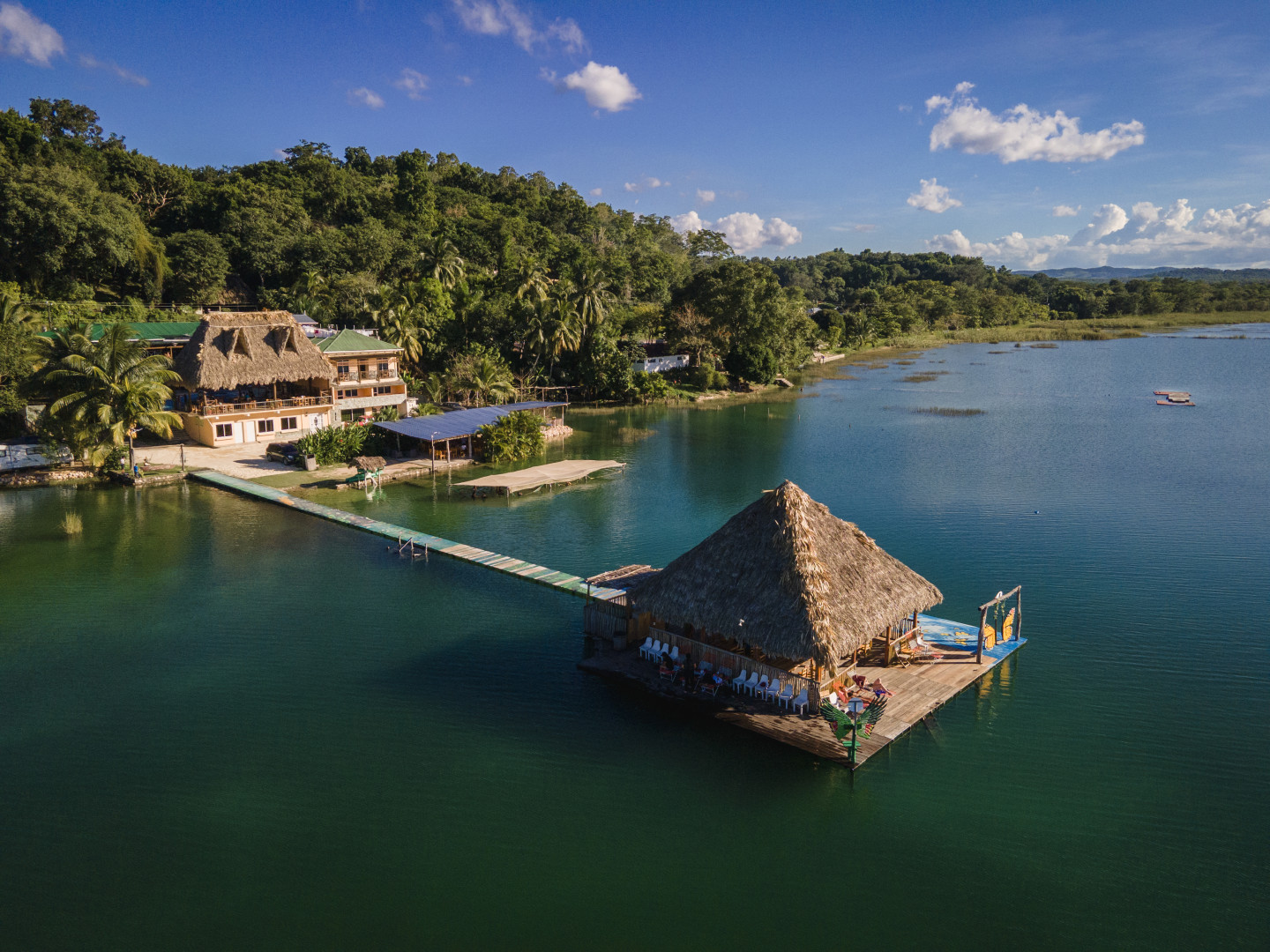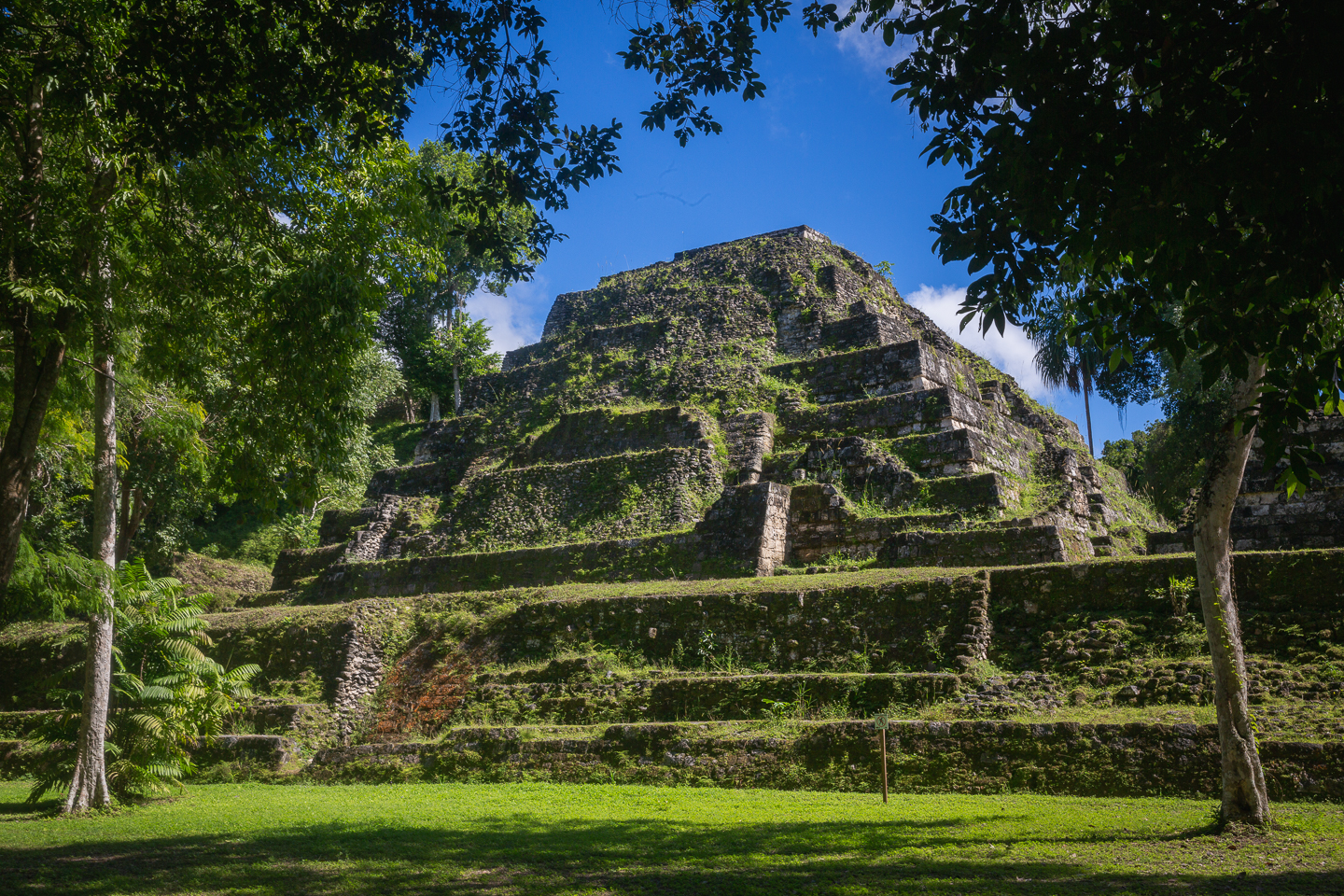 Nord Guatemala (Petén)
Nord Guatemala (Petén)

Northern Guatemala (Petén) is a lush, wild frontier where ancient Maya cities rise from dense jungles. Home to the legendary Tikal, its towering temples whisper tales of a lost civilization. Adventure seekers can explore remote ruins, spot exotic wildlife, and paddle serene rivers. This untamed region offers a rare blend of history, nature, and mystery—perfect for those craving an off-the-beaten-path escape.
L'essentiel
- Mois les plus propices à la visite : Décembre, février, janvier, novembre
zone Faits
- Geographical Location: Northernmost department of Guatemala, bordering Mexico to the north and west, Belize to the east, and the Guatemalan departments of Alta Verapaz and Izabal to the south.
- Main City/Town: Flores, the departmental capital, situated on an island in Lake Petén Itzá.
- Approximate Area: Approximately 35,854 sq km (13,843 sq miles), making it the largest department in Guatemala.
- Key Geographical Features:
- Lake Petén Itzá
- Maya Biosphere Reserve (includes tropical rainforests and archaeological sites)
- Río Usumacinta (forms part of the border with Mexico)
- Dominant Climate Type: Tropical monsoon climate (hot and humid with distinct wet and dry seasons).
- Population: Approximately 600,000 (as of recent estimates).
- Main Economic Activities:
- Tourism (centered around Maya ruins like Tikal)
- Agriculture (oil palm, corn, beans)
- Forestry (sustainable and illegal logging)
- Common Languages/Dialects Spoken: Spanish (dominant), Itza’ Maya (endangered), and other Maya languages like Q'eqchi'.
- Best Time to Visit: Dry season (November to April) for comfortable exploration of archaeological sites and nature reserves.
- Unique Selling Points:
- Home to Tikal, one of the most iconic ancient Maya cities, surrounded by lush jungle.
- Rich biodiversity in the Maya Biosphere Reserve, including jaguars, howler monkeys, and exotic birds.
Visites et excursions d'une journée
Tikal National Park: The Crown Jewel of the Maya World
Step into the heart of the ancient Maya civilization with a day trip to Tikal National Park, a UNESCO World Heritage Site. Towering pyramids emerge from lush jungle canopies, where howler monkeys and toucans add to the mystical atmosphere. Explore iconic temples like Temple IV, offering panoramic views at sunrise or sunset. Ideal for history buffs and nature lovers, this full-day excursion (about 1.5 hours from Flores) combines archaeology and wildlife spotting.
Yaxhá-Nakum-Naranjo Biotope: Off-the-Beaten-Path Maya Ruins
For travelers seeking a quieter alternative to Tikal, the Yaxhá-Nakum-Naranjo Biotope delivers breathtaking ruins surrounded by pristine rainforest. Yaxhá’s hilltop temples overlook serene lagoons, while Nakum’s well-preserved structures reveal intricate carvings. This full-day tour (2.5 hours from Flores) includes hiking and birdwatching, perfect for adventure seekers and those craving solitude.
Actun Kan Cave Exploration: Underground Adventure
Delve into the subterranean wonders of Actun Kan, a sacred Maya cave system near Flores. Navigate stalactite-filled chambers and underground rivers, learning about its ritual significance. This half-day tour (30 minutes from Flores) suits thrill-seekers and families with older kids, offering a mix of spelunking and cultural insight.
Lake Petén Itzá Boat Tour & Flores Island Stroll
Unwind on a scenic boat tour across Lake Petén Itzá, stopping at secluded swimming spots and the charming town of San Miguel. Wander Flores Island’s cobblestone streets, lined with pastel colonial buildings and lakeside cafes. This relaxed half-day trip (departing from Flores) is ideal for couples and leisure travelers.
El Mirador Trek: The Ultimate Jungle Expedition
Embark on a multi-day trek to El Mirador, one of the largest and oldest Maya cities, hidden deep in the Petén jungle. Hike through biodiverse reserves, camp under starry skies, and discover the towering La Danta pyramid. This 4-5 day expedition (starting from Flores) is tailored for hardcore adventurers and archaeology enthusiasts.
Quand visiter
Répartition saisonnière
Northern Guatemala (Petén) experiences a tropical climate with distinct wet and dry seasons. The region does not follow traditional spring, summer, autumn, and winter cycles but rather alternates between rainy and dry periods.
Dry Season (November – April)
The dry season is characterized by warm temperatures, low humidity, and minimal rainfall. Daytime temperatures range from 25°C to 32°C (77°F to 90°F), with cooler nights. This is the peak tourist season due to the favorable weather.
- Pros: Ideal for exploring archaeological sites like Tikal and Yaxhá without muddy trails. Wildlife spotting is easier as animals gather around water sources.
- Cons: Higher tourist crowds and elevated accommodation prices, especially around Christmas, Easter, and New Year.
- Events: Semana Santa (Holy Week) in March/April features vibrant processions and cultural celebrations.
Wet Season (May – October)
The wet season brings frequent afternoon showers and higher humidity. Temperatures remain warm, averaging 28°C to 35°C (82°F to 95°F). Rainfall peaks in September and October, sometimes causing road closures.
- Pros: Lush green landscapes, fewer tourists, and lower prices. Birdwatching is exceptional during this time.
- Cons: Some remote sites may be inaccessible due to flooding or muddy conditions. Mosquito activity increases.
- Events: The Fiesta de San José in March (varies by town) and Independence Day celebrations in September.
Shoulder Seasons (Late April – Early May & Late October – Early November)
These transitional periods offer a balance between dry and wet conditions. Rainfall is sporadic, and temperatures are moderate.
- Pros: Fewer crowds, lower prices, and comfortable weather for outdoor activities.
- Cons: Unpredictable rain showers may disrupt plans.
Recommandation générale
The best time to visit Northern Guatemala (Petén) is during the dry season (November – April) for optimal weather and accessibility to archaeological sites. However, budget travelers and nature enthusiasts may prefer the wet season (May – October) for its lush scenery and lower costs. Shoulder seasons provide a happy medium for those seeking a balance.
Considérations
Peak tourist seasons (December – March) see higher prices and crowded attractions. Booking accommodations and tours in advance is recommended. Off-peak travel (May – October) offers savings but requires flexibility for weather-related disruptions.
Ce qu'il faut emporter
Essentials for the Jungle & Mayan Ruins
Northern Guatemala (Petén) is a hot, humid region covered in dense jungle and home to iconic Mayan ruins like Tikal. Pack for adventure, bugs, and sudden downpours.
- Lightweight, long-sleeved shirts & pants: Protects against mosquitoes (which carry diseases like dengue) and sun exposure while exploring ruins or trails.
- DEET-based insect repellent (25-50% concentration): Essential for deterring aggressive mosquitoes and other biting insects in the jungle.
- Sturdy, breathable hiking shoes: Terrain around ruins and jungle paths is often uneven, muddy, or slippery.
- Compact rain poncho or quick-dry rain jacket: Sudden tropical showers are common, especially in the rainy season (May-October).
- Reusable water bottle with purification tablets/filter: Tap water isn’t safe to drink, and hydration is critical in the heat.
Gear for Exploration
Petén’s archaeological sites and wildlife demand some specialized items.
- Binoculars: For spotting howler monkeys, toucans, and other wildlife in the jungle canopy.
- Headlamp or flashlight: Useful for early morning or sunset visits to ruins (e.g., Tikal opens at 6 AM).
- Quick-dry microfiber towel: Handy for wiping sweat or drying off after rain.
- Small backpack with rain cover: Keeps gear dry during hikes or boat trips to remote sites like Yaxhá.
Cultural & Practical Extras
- Modest clothing for villages: Lightweight but conservative attire (covered shoulders/knees) shows respect in rural communities.
- Spanish phrasebook or app: English is less common here than in touristy areas like Antigua.
- Cash in small bills (GTQ): Many local vendors and transport options don’t accept cards.
Comment s'y rendre
Par avion
The primary gateway to Northern Guatemala (Petén) is Mundo Maya International Airport (FRS), located near Flores, the region's main hub. This airport serves both domestic and limited international flights, with connections from Guatemala City (La Aurora International Airport - GUA) and some Central American destinations. From the airport:
- Taxi or shuttle: Shared shuttles or private taxis are readily available for transfers to Flores (10-15 minutes) or nearby towns like Santa Elena.
- Rental car: Several agencies operate at the airport, ideal for exploring Petén's remote archaeological sites like Tikal.
For international travelers, flying into Guatemala City (GUA) and connecting to FRS via a 1-hour domestic flight is the most efficient option. Book flights in advance, especially during peak seasons (November-April).
En bus/car
Long-distance buses are a budget-friendly way to reach Petén from major Guatemalan cities:
- From Guatemala City: Direct overnight buses (8-10 hours) depart from Terminal de Autobuses del Norte, operated by companies like Línea Dorada or Fuente del Norte. These arrive in Santa Elena/Flores, with connections to Tikal and other sites.
- From Belize: Buses run from Belize City (6-7 hours) to Flores via the border crossing at Melchor de Mencos.
Tip: Opt for first-class (lujo) buses for comfort, and book tickets a day ahead. Buses can be crowded, so secure your belongings.
En voiture (conduite)
Petén is accessible via Guatemala's CA-13 highway, which connects to Guatemala City (via CA-9) and Belize. Key routes:
- From Guatemala City: Take CA-9 north to Río Dulce, then CA-13 to Flores (6-8 hours). Roads are paved but winding; avoid night driving.
- From Belize: Enter via Melchor de Mencos, then follow CA-13 south to Flores (2-3 hours). Border crossings require paperwork; check visa requirements.
A 4x4 is recommended for exploring off-the-beaten-path sites like El Mirador, where roads are unpaved and muddy in the rainy season (May-October). Fuel stations are sparse outside Flores—fill up beforehand.
Se déplacer
Public Buses and Colectivos
The backbone of local transport in Petén is the network of public buses and colectivos (shared minivans). These are affordable and connect major towns like Flores, Santa Elena, and El Remate with key attractions such as Tikal and Uaxactún. Buses are often crowded but reliable, while colectivos offer faster, slightly more comfortable rides for a higher fare.
- Routes: Flores to Tikal (1.5 hours) is the most popular; colectivos also run to smaller ruins like Yaxhá.
- Cost: Buses cost around GTQ 25–50 (USD 3–6); colectivos charge GTQ 50–100 (USD 6–12). Pay in cash directly to the driver.
- Tip: Depart early (by 5 AM for Tikal) to avoid midday heat and crowds.
Taxis et covoiturage
Taxis are widely available in Flores and Santa Elena, often without meters. Negotiate fares upfront (e.g., GTQ 50–150/USD 6–18 for short trips). Ride-sharing apps like Uber do not operate here, but hotels can recommend trusted drivers for longer journeys.
- Airport Taxis: From Mundo Maya International Airport (FRS), fixed rates apply (around GTQ 100/USD 12 to Flores).
- Advantage: Convenient for door-to-door service to remote lodges or sunset viewpoints like Cerro Cahuí.
Car and Motorcycle Rentals
Renting a car or motorcycle (GTQ 300–600/USD 35–70 per day) offers flexibility for exploring off-the-beaten-path sites like El Mirador or Río Azul. Roads are often unpaved and rough—4x4s are recommended.
- Requirements: International driver’s license and cash deposit usually needed.
- Caution: Fuel stations are sparse outside towns; fill up in Santa Elena.
Boats and Water Transport
In Flores, lanchas (small boats) shuttle across Lake Petén Itzá to villages like San José (GTQ 10–20/USD 1–2.50 per person). Private boats can be chartered for sunset tours or trips to secluded swimming spots.
- Tip: Bargain for group rates if visiting islands like Isla de los Pájaros.
Walking and Cycling
Flores is highly walkable, with its cobbled streets and compact size. Bike rentals (GTQ 50–100/USD 6–12 per day) are ideal for exploring lakeside paths or nearby caves like Actún Kan.
- Caution: Limited bike lanes; carry a lock and avoid riding at night.
Des transports locaux uniques
Tuk-tuks (auto-rickshaws) zip around Flores and Santa Elena for short hops (GTQ 10–20/USD 1–2.50). Fun and cheap, but confirm the fare before boarding.
Culture
Cultural Identity of Petén
Northern Guatemala's Petén region is a cultural crossroads, blending ancient Maya heritage with the rhythms of contemporary rural life. Unlike the highland indigenous communities, Petén's culture is shaped by its lowland jungle environment, sparse population, and proximity to Mexico and Belize. The region is the heartland of the Classic Maya civilization, and its modern identity remains deeply tied to archaeological sites like Tikal and El Mirador. Locals, known as Peteneros, maintain traditions rooted in forestry, agriculture, and a slower-paced way of life distinct from Guatemala's more urbanized regions.
Maya Heritage & Traditions
Petén is home to descendants of the Itza Maya, whose language was spoken here until the early 20th century. While Spanish dominates today, Maya spiritual practices persist, particularly in ceremonies honoring Yum Kax, the maize god, and rituals at sacred caves like Actun Kan. Traditional chiclero (chicle harvesters) culture, tied to the gum industry, is celebrated in Flores with festivals featuring marimba music and dances like the Danza del Venado (Deer Dance).
Cuisine: Jungle Flavors
Petén's cuisine reflects its isolation and natural bounty. Staples include:
- Pescado blanco (white fish) from Lake Petén Itzá, often grilled with local spices
- Chirmol (a tomato-based sauce) served with game meats like venison or wild boar
- Tamales de elote (sweet corn tamales) wrapped in maxán leaves instead of corn husks
Festivals & Social Customs
Petén's festivals blend Catholic and Maya traditions with local flair:
- Feria de San José (March) in Flores features bullfights and canoe races
- Día de los Muertos celebrations include visits to jungle cemeteries adorned with marigolds
- La Chatona, a towering folkloric puppet, dances at local celebrations
Arts & Handicrafts
Petén's crafts utilize jungle materials:
- Jícaras (carved gourds) decorated with scenes from Maya mythology
- Palo de Campeche (dyewood) used in traditional textile coloring
- Ceramics mimicking Pre-Columbian styles from nearby archaeological sites




